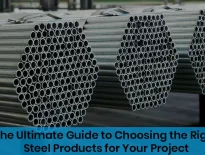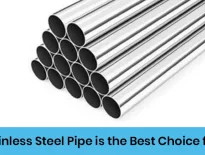Comprehend seamless carbon steel pipe, pipe grading, piping advantages, and the proper selection of seam-welded or seamless pipe for a host of industrial applications.
What is Carbon Steel?
Alloyed with carbon in an amount that ranges from 0.05% to 2.0%, carbon steel is known for its strength and durability, as well as for its economy. These are the reasons that carbon steel is found in such abundance in the industrial sector. Among the different types of steel, it is by far the most frequently used.
Depending on how much carbon it contains, carbon steel can be low, medium, or high in carbon. If it has less than 0.35% carbon, steel is classified as low-carbon. Those with 0.35% to 0.50% are medium-carbon steel, and those with 0.50% to 0.90% (which is more like 0.5% to 2.0% range for us here) are classified also as high-carbon steel.
Why Use Carbon Steel for Piping Applications?
Piping made of carbon steel is a common sight in use. It is in many ways the perfect material for the applications to which we direct piping. Carbon steel has strength enough to handle the pressures and the temperatures that many of our industrial processes generate. And it has versatility to direct that strength into a huge number of process streams.
What is a Carbon Steel Seamless Pipe?
A CS seamless pipe is a pipe made without any welding seams. It is manufactured by piercing a solid billet and then elongating it into a hollow tube through hot or cold rolling. As a result, the seamless pipe has a uniform structure with very few weak spots (if any) and is capable of withstanding very high pressures.
Seamless vs Welded: What’s the Difference?
Seamless pipes, made from a single piece of metal, contrast with welded pipes, which are formed by rolling and welding a flat steel plate. Because they handle pressure better and are more uniform and stronger, seamless pipes are preferred in most high-stress applications.
Carbon Steel Pipe Grades
Pipes made of carbon steel come in all sorts of grades, with each one being individualized for the specific application it is meant to serve—be that application determined by temperature, pressure, or the material being conveyed through the pipe. The trick is knowing which to choose for any given project.
- ASTM A106 – This grade is extensively applied for high-temperature jobs. It suits seamless pressure pipe applications and is something you’re likely to encounter in refineries, power plants, and boilers. A106 pipes can take crazy heat and pressure, which makes them something you might use in a superheated steam service or for transferring high-temperature fluids.
- ASTM A53 – Pipes made from A53 specifications are appropriate for low to medium pressure and are used in structural applications or water, steam, and air systems. They come in both welded and seamless forms and are versatile across commercial and industrial projects.
- API 5L – Created by the American Petroleum Institute, this grade is meant for carrying oil, gas, and water through pipelines. API 5L pipes provide first-rate strength and resistance to corrosion, especially in sour service settings. It’s an oil and gas industry benchmark.
- ASTM A333 – This grade is intended for low-temperature work, usually in the application of cryogenics or cold-weather processes. The A333 pipe is stress-relieved and has good impact resistance at sub-zero temps, making it a prime choice for the colder parts of the world.
Comparison Table of Carbon Steel Grades
| Grade | Application | Temp Range | Key Features |
| A106 | Boilers, refineries | Up to 750°F | High temp & pressure resistance |
| A53 | Water, steam, air lines | Up to 550°F | Versatile, economical |
| API 5L | Oil & gas pipelines | Varies | Seamless flow, corrosion resistance |
| A333 | Low-temp service | -50°F to +650°F | Toughness in sub-zero conditions |
Specifications of Carbon Steel Seamless Pipes
Seamless pipes of carbon steel are offered in various standards, sizes, and lengths. The majority fall under the specific ASTM, API, and ASME sets of standards. They can be produced to a number of different specifications, with some of the more common ones being for either hot-rolled or cold-drawn pipe, and are generally supplied with either smooth, plain, or grooved ends. Bevels on the ends are optional but fairly common.
| Specification | Description |
| Standard Sizes and Dimensions | Available in a wide range of diameters and wall thicknesses, following nominal pipe sizes (NPS) and schedules (e.g., Schedule 40, Schedule 80). |
| Wall Thickness | Varies depending on application; thicker walls provide higher pressure ratings and strength. |
| Material Grades | Common grades include: – ASTM A106: High-temperature and high-pressure applications. – ASTM A53: Low to medium pressure applications (water, steam, air). – API 5L: Oil and gas pipelines with corrosion resistance. – ASTM A333: Low-temperature service, cryogenics. |
| Manufacturing Process | Made without seams by piercing a solid billet and elongating it into a hollow tube through hot rolling or cold drawing. |
| End Finishes | Can have plain ends, beveled ends, or threaded ends to facilitate pipe joining. |
| Surface Finish | Includes smooth or coated finishes such as: – Galvanization: Zinc coating for corrosion resistance. – Epoxy Coatings: Protection against corrosion in harsh environments. – Paint Linings: Added durability and corrosion protection. |
| Pressure and Temperature Ratings | Varies by grade and wall thickness, with specific ratings for high-temperature and high-pressure applications. |
| Compliance with Standards | Manufactured to meet ASTM, API, and ISO standards for safety, quality, and performance. |
| Tensile Strength and Yield Strength | Tested for tensile strength and yield strength to determine force limits before deformation or failure. |
Applications of Carbon Steel Seamless Pipes
- Oil and Gas Sector – The oil and gas sector employs carbon steel seamless pipes on a grand scale, covering upstream (drilling), midstream (transport pipeline), and downstream (refinery) operations. When it comes to transporting crude oil, natural gas, and petroleum derivatives over long distances, these pipes have strength to spare and then some; they’re really, really good at not bursting and making other stuff ‘go boom’ under high internal pressure.
- Petrochemical and Refinery – In chemical plants and refineries, the pipes encounter corrosive fluids, high-pressure steam, and volatile chemicals. Their durability and heat resistance make them a reliable choice for complex refinery systems and reactor piping.
- Power Plants and Boilers – Superheaters, boilers, heat exchangers, and feedwater systems rely on high-performance carbon steel pipes. These pipes endure the extreme heat and pressure that assure nearly continuous power generation.
- Automotive and Construction – Seamless pipes are used in the automotive and construction sectors to manufacture chassis, suspension parts, and components for hydraulic systems. They are also used for structural frameworks and scaffolding. Seamless pipes are highly resistant to tensile and impact forces, and that makes them a dependable material for mechanical and structural applications.
Benefits of Using Carbon Steel Seamless Pipes
Durability and Strength
Seamless carbon steel pipes possess a remarkable mechanical strength. They are structurally uniform and less prone to failure under pressure or mechanical stress. This makes them reliable in applications where everything is on the line, like oil rigs and power plants. Their strength also makes them good for heavy-duty structural applications, in construction and mechanical systems.
Pressure and Heat Resistance
Carbon steel seamless pipe can withstand high pressure and high temperature. The absence of seams reduces the number of weak points in the body of the pipe, which in turn lowers its chances of cracking or bursting when it’s used to carry any of these to the other side: hot gases, steam, or high-pressure fluids. That’s why seamless pipe is a go-to choice for critical systems like these:
- Boilers
- Steam lines
- High-pressure fluid transport
If your life depends on the performance of climate control, you want a seamless carbon steel pipe in its constitution
Corrosion Resistance with Protective Coating
Despite how carbon steel is prone to corrosion, protective methods that are nothing short of modern miracles have greatly enhanced its rust resistance. These methods include:
- Galvanization
- Epoxy coatings
- Paint linings
Once a carbon steel pipe has been coated in any combination of these three nifty methods, it becomes phenomenally well-suited for moist or corrosive environments, including underground pipelines or installations near coastlines. Indeed, once either kind of coated pipe is set up in such an environment, the chances of its developing a serious corrosion problem in the first 25 years of its operation are extremely slim.
- Service life: 25 years
- Maintenance costs: low
- Reliability: very high
How to Choose the Right Grade for Your Project
Primary Considerations: Pressure, Heat, Surroundings
Gauge the working pressure, heat, and the type of fluids being moved. Environmental elements, like chemical exposure, humidity, or severe weather, also exert a strong influence on selection.
Used case based grade selection chart
| Application Type | Recommended Grade |
| High temp service | A106 |
| General transport | A53 |
| Oil & gas pipelines | API 5L |
| Cold environments | A333 |
Conclusion – Final Thoughts on Choosing the Right Seamless Pipe
Choosing the right carbon steel seamless pipe means comprehensively understanding your working conditions and matching them to the right steel grade and pipe spec. If your project requires something that’s tough and just not gonna fail, or something that can withstand extreme heat or incredible pressure, count on carbon steel seamless pipe to deliver the performance you demand. As with any structural or mechanical element in any project, the pipe must be of high quality and made by a reputable company.
Ready to find the perfect carbon steel seamless tube for your project? Contact Solitaire Overseas today for expert guidance and a competitive quote.


